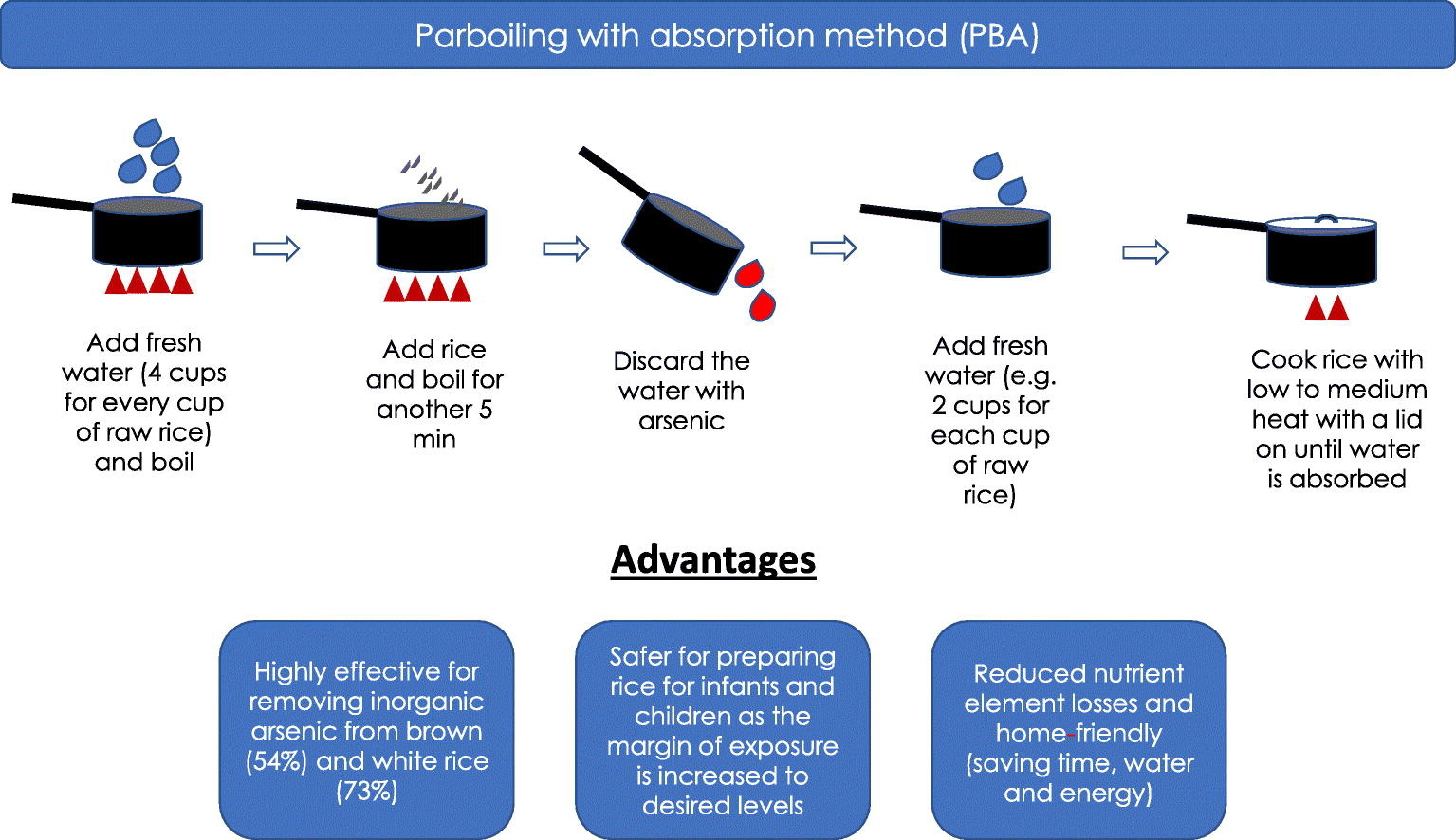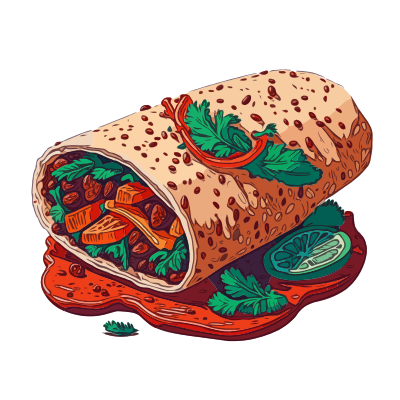Why you should know:
Arsenic is a carcinogen and has various other negative health effects; enough to warrant exposure limits in various jurisdictions. A five minute boil-and-discard step before cooking is a simple way to reduce your exposure, especially if you eat a lot of rice.
Details are in the study, linked in the title of this post. Here’s a diagram from the abstract:

Wow, lot to unpack here.
-
“Ain’t nobody got time for that.”
-
How much arsenic are we talking about here?
-
“Saving time, water, and energy” is apparently short for boil water, stand around, drain, re-boil more water using more energy, and finish cooking rice. Where is all this time saving happening?
-
“The margin of exposure [to arsenic] is increased to desired levels”. Hmmm I guess if you really think about it that is a true statement, but one heck of a roundabout way to say it.
You were being generous going past (1.) I rather just die or stop reading rice
- This seems to mainly be a concern in places where a lot of rice is consumed and there is no legal limit for arsenic in rice (many parts of Asia), not necessarily in the US where there is an FDA limit and most people don’t eat rice every day.
- It saves time, water, and energy compared to other ways of reducing arsenic, like using the excess water method with large excesses of water. Parboiling in with 4 times the water by weight and then cooking in 2 times the water by weight uses less water than cooking once in 10-12 times the water by weight (half the water). Heating half as much water to boiling reduces energy use and time (assuming constant heating power in W from the stove). Of course it’s still slower than cooking rice using the absorption method common in many places (this is not necessarily how people in some countries cook rice).
Haha guess so. Misleading graphic taken out of context. That makes more sense. I never tried the excessive water method. It sounded interesting, but I refer to my point #1 above.
The article explains the infographic and adds a lot more context.
The amount of arsenic depends on location - if you’re in a region that has standards on arsenic levels, like the EU, UK, or the US, then you’re probably fine, but the levels may be higher than what’s considered safe for children. This method would allow you to reduce the levels by around 50%, and since the levels for children are a bit under half of what’s acceptable for adults, that’s likely to make it safe for them.
The time savings are relative to other methods for reducing arsenic content, like cooking it with excess water (like a 12:1 ratio) and then discarding the excess, as this method allows you to use a rice cooker for the remaining time and to cook with a much smaller water:rice ratio, even accounting for the discarded water.
Yeah, took me a while to get through that paper. Pretty detailed, but a little red flag kept waving when all the results are percentages. I finally got down to the meat of the science and was pretty confused on actual levels. I still don’t have a good grasp of exactly how much iAs they measured, as the findings are adjusted for relative exposure by body weight. I suppose that’s the point of the paper, but would have been nice to have some relatable baseline to put things in perspective.
There is also a pretty large margin of error as a exposure 2.75x greater than used to calculate the results was within the same exposure limits linked to the 0.1% risk. That’s easy to add to their charts. Would have been nice.
-
is that why that one british lady Uncle Roger was roasting drained her rice?
Ysk your body can naturally get rid of arsenic so this is pointless.
The only reason I started eating more rice in the last decade or so, was one click cooking. If you want me to use a process more complex than “dump equal rice and water in rice maker then click start”, I’m afraid the alternative is potatoes
Im with you.
Sorry, everything these days causes cancer. Let me have a quick easy dinner so this life is worth it.
Yeah, I’m getting a prop 65 warning tattooed on my ass one of these days. That way I can just enjoy life knowing I’ve been told.
The microplastics in my body laugh at arsenic’s petty attempt on my life!

Do you “discard” the water by… just letting it into the sink? How long before aresnic is everywhere?
Arsenic is a naturally occurring element.
Does it come with old lace?
You can actually buy parboiled rice which have been dried. It’s very close in price to white rice and not as sticky as regular rice.
It takes just as long to cook, and has the texture of parboiled rice.
Helpful advice? Who ARE you?
Scientists of discovered that saliva causes stomach cancer but only when swallowed in small amounts over a long period of time.
Give me the arsenic because there is no way I’m overcooking my rice to remove it
This is not suggesting the rice be overcooked, just cooked using a different process.
deleted by creator
Yes, thank you for the correction. I edited it.
And bananas are radioactive. Best leave them a few halflives before scraping the mouldy gunky remains from your fruit bowl.
It takes 40 mins to fully cook brown rice plus the 5-8 mins it takes for it to boil. This will add 15-20 mins more to overall cooking. As someone who eats rice almost everyday, I’ll probably want to start doing this, but man that’s a lot more time and water wasted 😞
This will add 15-20 mins more to overall cooking.
Are you counting 5-8 minutes to heat water + 5 minutes parboiling the rice + 5-8 minutes to heat fresh water? If so, you’re double-counting one of those steps, because you already have to heat water when cooking rice. Using your figures, the overall cooking time would only increase by 10-13 minutes.
You could reduce that to ~5 minutes by heating your cooking water during the parboil step, rather than after, so it’s ready to go when the parboil is done. In a kettle or second pan, for example.
You could further reduce it to <1 minute (the time it takes to replace the parboil water) by taking 5 minutes off the cooking time, since the newly added 5 minute parboil is cooking.
I hope the fediverse doesn’t cook meals one step at a time. That would take ages. :)
I’m asian and grew up in Asia cooking rice without a rice cooker. This is how we do it:
- 1:2 rice to water ratio
- Wash rice
- Put rice and water in a sauce pan(?) or whataver you call that pan with deep sides.
- Turn on stove to high heat until water boils (This is the initial 5-8 mins)
- Once boiling, turn down heat to low and simmer for 40 mins (for brown rice. White rice is 20-25, broken rice is 12-15)
If I was to boil the rice for 5 mins and throw the water out, that means I need to boil water first (5-8 mins), throw in the rice and wait 5 minutes, then throw out the water. Only then will I do the above steps. The fresh water needs to boil again (5-8 mins) before I simmer for 40 mins.
Good point on heating the new batch of water while doing the initial boil. I can’t say I’ve ever cooked rice by throwing it into already boiling water though, so we’ll see how it turns out.
I can’t say I’ve ever cooked rice by throwing it into already boiling water though,
Do you mean when replacing the parboil water? At that point, the rice would already have been brought to a boil gradually. Discarding the parboil water and pouring in fresh boiling water wouldn’t be like throwing dry rice into a boiling saucepan.
Or are you thinking of changing your process, by no longer bringing the water to a boil with the rice already in it, but instead waiting to add the rice until after the parboil water has reached a full boil? I realize that’s what the infographic shows, but I don’t think it’s necessary to do it that way. If anything, I would expect your way (bring rice & water to a boil together) to pull out more arsenic.
I’ve been parcooking rice like this for about 3 years now. It’s very little effort and doesn’t change the rice enough to matter.
Oh boy, someone better go back and tell all of Asia for the last 10,000 years
This is a growing problem due to climate change (higher temperatures seem to increase arsenic uptake) and pollutants, so this doesn’t make any sense.
deleted by creator
How much arsenic water would you need to distill down to get a useful amount of arsenic?
Asking, for science
Of course.
How much arsenic do you define as useful? I had a similar thought and could probably figure it out, but I really don’t want to dig my old chem and bio texts out of my garage.
The real question. Apple seeds have naturally occurring cyanide, but you would have to eat something like 30 to 300 apples worth of seeds to maybe have a health issue.
It’s the dose that makes the poison.
Aren’t you better off with plum or peach seeds?
Best not to eat any, but it’s still a matter of dose. Plum/peach seeds may be more a choking hazard than any other.
Let’s do the math. Rice contains about 0.4 mg/kg As by weight. The “bad” rice in Louisiana or whatever contains about 75% more - about 0.7 mg/kg. Let’s round up to 1 mg/kg to make the math easy. Chronic exposure limits for a 50 kg adult are about 5 mg/day (on the low end).
So you’d have to choke down a full 10 lb bag of rice every day (about 110 cups of cooked rice) to start to tip the scales. Other sources of arsenic, like groundwater, are likely far more significant.
Comment stolen from reddit
Soooo it’s safe to eat without throwing the eater out?
Well, if you were previously throwing anyone who ate the rice in the garbage, then yes, not doing that would be safe.
sorry, I ^couldn’t ^ resist. yes, it’s safe to eat rice without throwing out the first batch of water. see rest of this thread for nuance.
Challenge accepted.










